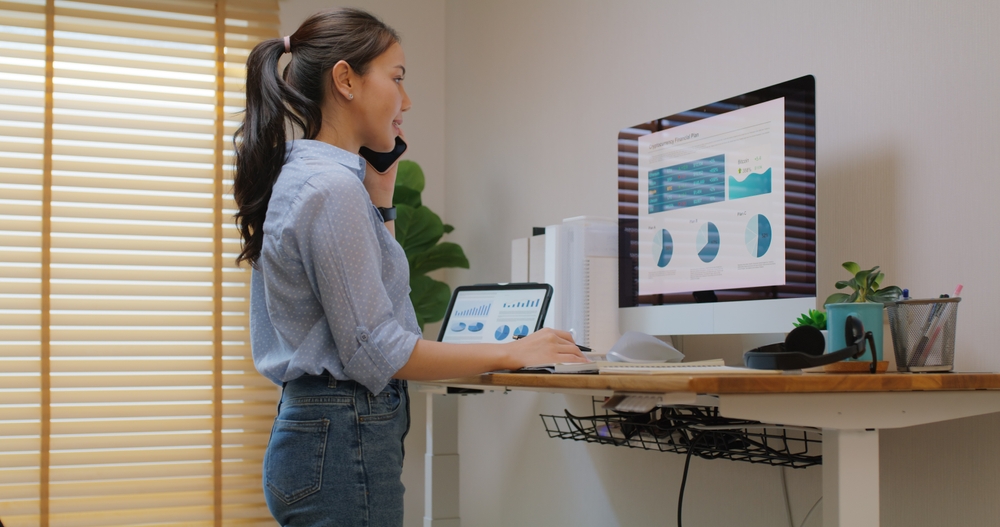Introduction: What is Desk Job Vein Damage and Why You Should Know
Desk jobs harm veins through prolonged sitting that restricts blood flow, weakens vein walls, and increases pressure in leg veins, leading to conditions like varicose veins and deep vein thrombosis. Research shows desk workers face a 2.8-fold higher risk of developing serious vein problems compared to those in active professions.
This comprehensive guide covers how sitting damages your vein health, early warning signs to recognize, and proven strategies to protect your veins while maintaining your career. You’ll discover why standing desks alone aren’t the solution and learn evidence-based prevention methods that actually work.
Understanding How Desk Jobs Damage Your Vein Health
Core Vein Function and Circulation Basics
Healthy veins rely on calf muscles acting as pumps, helping veins push blood back to your heart against gravity. When blood flows efficiently through healthy blood vessels, vein walls maintain their strength and elasticity. However, prolonged sitting disrupts this natural process.
During extended periods of sitting, your calf muscles remain inactive, causing blood to pool in leg veins. This pooling increases vein pressure dramatically, putting stress on vein walls and causing veins to weaken over time. The result is poor circulation that can progress from minor discomfort to serious vein disease.
The Desk Job-Vein Damage Connection
Prolonged periods of immobility create the perfect conditions for vein problems to develop. When you sit for long hours without movement, several harmful processes occur:
- Blood moving through your legs slows significantly
- Increased pressure in leg veins stretches and damages the vein walls
- Risk of developing blood clots rises with each hour of inactivity
- Venous insufficiency begins as the vein valves start failing
Studies indicate that sitting for more than 6 hours daily begins affecting circulation, with significant damage occurring at 8+ hours. Each additional hour of sitting increases your risk of developing vein issues by approximately 10%.
Why Desk Jobs Pose Unique Risks to Vein Health
Statistical Evidence and Risk Factors
Office workers face unprecedented vein health challenges. The average desk job requires 6-12 hours of daily sitting, creating a sedentary lifestyle that previous generations never experienced. Research reveals alarming statistics:
- 40% increased risk of venous insufficiency in sedentary workers
- 2.8 times higher likelihood of deep vein thrombosis compared to active professions
- Over 25 million Americans suffer from vein disease, with desk workers representing a disproportionate percentage
Comparison with Active Professions
Workers in physically demanding jobs like healthcare, construction, and retail show significantly lower rates of vein problems. However, prolonged standing in one place also carries risks; those standing still for extended periods face higher chances of developing varicose veins due to constant gravitational pressure on leg veins.
Symptoms and Risk Assessment Guide
Early Warning Signs vs Advanced Symptoms
| Early Symptoms | Advanced Symptoms | Severity Level |
| Leg fatigue after sitting | Visible varicose veins | Mild to Moderate |
| Mild leg swelling | Skin discoloration | Moderate |
| Aching after long periods | Leg pain during activity | Moderate to Severe |
| Restless legs | Leg swelling that doesn’t resolve | Severe |
| Heavy feeling in the legs | Open wounds or ulcers | Severe |
Personal Risk Factors
Your risk of developing vein problems increases with:
- Family history of vein disease
- Age over 40
- Excess weight, which puts additional stress on leg veins
- Female gender (hormonal factors affect vein health)
- Medical history of blood clots
- Prolonged sitting or standing throughout the day
Step-by-Step Guide to Protecting Your Veins at Work
Step 1: Assess Your Current Vein Health Status
Begin with an honest evaluation of your daily routine and symptoms. Track how many hours you spend sitting or standing without movement. Note any leg pain, swelling, or visible changes in your veins. Consider your family history and other risk factors.
Create a baseline measurement of your calf circumference and document any discomfort levels. This baseline helps you monitor improvements as you implement protective measures.
Step 2: Implement Immediate Workplace Modifications
Movement Strategies:
- Take regular breaks every 30-60 minutes
- Perform calf raises at your desk to activate muscle pumps
- Schedule walking meetings when possible
- Use stairs instead of elevators
- Park farther away or exit public transit one stop early
Ergonomic Adjustments:
- Ensure proper footwear that doesn’t restrict blood flow
- Avoid crossing your legs while sitting
- Use a footrest to improve leg positioning
- Consider compression stockings for gentle pressure that encourages blood flow
Standing Desk Considerations: Standing desks can help, but prolonged standing creates their own risks. Alternate between sitting and standing every 30-45 minutes rather than standing all day. The key is movement variation, not simply replacing sitting with standing.

Step 3: Develop Long-term Vein Health Habits
Daily Practices:
- Elevate your legs above heart level for 15-20 minutes after work
- Perform leg exercises specifically designed to improve circulation
- Maintain a healthy weight to reduce pressure on leg veins
- Stay hydrated to keep blood flowing smoothly
Weekly Monitoring:
- Check for new spider veins or changes in existing ones
- Monitor leg swelling patterns
- Track energy levels and leg comfort throughout the day
- Assess the effectiveness of your prevention strategies
Common Mistakes That Worsen Vein Damage
Mistake 1: Relying Solely on Expensive Equipment – Many workers invest in expensive ergonomic chairs or standing desks, expecting complete protection. While these tools help, movement frequency matters more than equipment cost.
Mistake 2: Ignoring Early Symptoms – Dismissing leg heaviness, fatigue, or minor swelling as “normal” allows vein damage to progress. Early intervention prevents minor issues from becoming serious vein conditions requiring medical treatment.
Mistake 3: Inconsistent Prevention Efforts – Sporadic movement breaks or occasional use of compression stockings won’t protect your vein health. Consistency in preventive measures is essential for maintaining healthy circulation.
Pro Tip: Focus on building sustainable movement habits rather than dramatic workplace overhauls. Small, consistent changes protect veins more effectively than sporadic intensive efforts.
Benefits of Making Adjustments at the Workplace for Vein Health
Implementing workplace adjustments can significantly improve vein health and reduce the risks associated with prolonged sitting or standing. Research highlights several benefits of ergonomic and behavioral changes that promote better circulation and prevent vein-related complications.
| Benefit | Description | Estimated Impact (%) |
| Enhanced Blood Circulation | Alternating between sitting and standing reduces venous pressure and prevents blood pooling. | Up to 30% improvement in circulation efficiency |
| Reduced Leg Swelling and Discomfort | Frequent movement and ergonomic support decrease leg swelling, heaviness, and pain. | 25-40% reduction in leg swelling reported |
| Prevention of Vein Disease Progression | Early interventions support vein walls and valves, slowing disease progression. | 20-35% lower risk of varicose veins development |
| Improved Employee Well-being and Productivity | Reduced discomfort leads to better focus, higher productivity, and fewer sick days. | Up to 15% increase in productivity |
| Long-term Health Benefits | Healthy circulation lowers the risks of cardiovascular diseases linked to poor vein health. | 10-20% reduced risk of related heart conditions |
Incorporating these adjustments is a proactive approach to maintaining healthy veins, ensuring that employees can work comfortably and safely while minimizing the hidden health risks associated with desk jobs.
Source: Adapted from “Workplace Interventions for Reducing Sitting Time and Improving Cardiometabolic Health,” PMC, 2020. https://www.ncbi.nlm.nih.gov/pmc/articles/PMC7363262/
Treatment Options for Existing Vein Problems
Minimally Invasive Procedures
For those with existing vein disease, modern treatment options offer effective solutions:
- Radiofrequency ablation: Uses heat to close affected veins under local anesthesia
- Sclerotherapy: Injection treatment for spider veins and small varicose veins
- Laser treatments: Target surface veins with minimal discomfort
- Compression therapy: Medical-grade stockings for ongoing management
These minimally invasive treatments typically require little downtime and can be performed in an office setting. Most patients return to desk jobs within days while maintaining preventive measures for overall health.
When to Seek Professional Help
Consult a vein specialist if you experience:
- Persistent leg pain despite preventive measures
- Rapid development of new varicose veins
- Significant leg swelling that doesn’t improve with elevation
- Skin discoloration around the ankles
- Any signs of blood clots (sudden severe pain, warmth, redness)
Vein Treatment at The Vein Centre in Nashville, TN
If you are experiencing vein problems or want expert advice on protecting your vein health, consider seeking medical treatment at The Vein Centre in Nashville, TN. Their team of specialists provides advanced, personalized care to diagnose and treat vein conditions effectively. Schedule a consultation today.
Remember that protecting your vein health while maintaining your desk job career is entirely achievable with the right knowledge and consistent action. Small daily changes compound into significant long-term benefits for your circulation and overall health.
Frequently Asked Questions About Desk Jobs and Vein Health
Q1: How quickly can desk job vein damage occur? Circulation problems can begin within weeks of starting a sedentary lifestyle. Visible varicose veins typically develop over months to years of prolonged sitting without preventive measures.
Q2: Are compression stockings necessary for all desk workers? While not mandatory for everyone, compression stockings provide gentle pressure that encourages blood flow and can prevent vein problems in high-risk individuals. Those with a family history or early symptoms benefit most from daily use.
Q3: Can standing desks completely prevent vein damage? Standing desks help, but aren’t a complete solution. Prolonged standing can actually increase the risk of developing varicose veins. The key is alternating positions and incorporating regular movement throughout the day.
Q4: Is vein damage from desk jobs reversible? Early-stage circulation problems often improve with consistent preventive measures within 3-6 months. However, established varicose veins typically require professional treatment, though progression can be prevented with proper vein care.
Q5: How does excess weight affect desk job vein problems? Carrying excess weight increases pressure on leg veins and compounds the negative effects of prolonged sitting. Maintaining a healthy weight significantly reduces your risk of developing serious vein conditions.
Conclusion: Essential Steps to Protect Your Veins at Work
Key Takeaway 1: Movement every 30-60 minutes is more crucial than expensive ergonomic equipment for maintaining healthy veins and preventing vein disease.
Key Takeaway 2: Early intervention prevents progression from minor circulation issues to serious conditions requiring minimally invasive procedures or surgery.
Key Takeaway 3: A combination approach, including regular movement, compression stockings, leg elevation, and proper ergonomics, provides the best protection for your vein health.
Key Takeaway 4: Both prolonged sitting and prolonged standing pose risks – the solution is regular position changes and consistent movement throughout the day.
Next Action Step: Starting tomorrow, set hourly reminders for 2-minute movement breaks and begin tracking your symptoms weekly. If you have a family history of vein problems or current symptoms, consider compression stockings and schedule a vein health evaluation. Your veins and overall well-being depend on the preventive measures you implement today.
Remember that protecting your vein health while maintaining your desk job career is entirely achievable with the right knowledge and consistent action. Small daily changes compound into significant long-term benefits for your circulation and overall health.
Contact The Vein Centre in Nashville, TN, to schedule an appointment and learn if you have any emerging vein conditions before they worsen.



